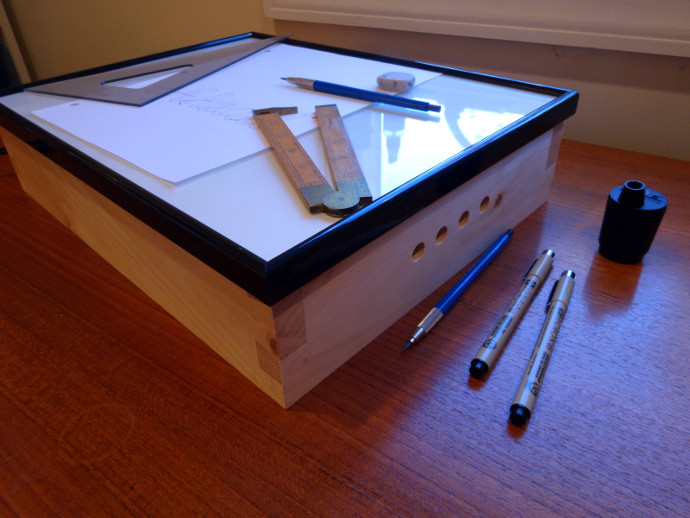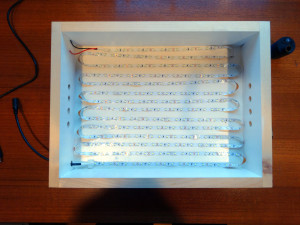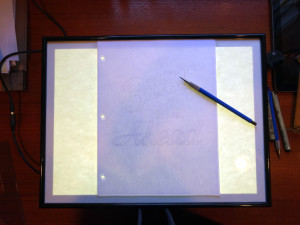If you are among those who do their drawing and drafting with modern computer tools, move along; nothing to see here.
This is a lightbox for tracing, not a lightbox for photographing objects.
I am among the club of old fogies who still use pencil and paper for all of my hand lettering as well as other design work. Many times, the next iteration is easy to accomplish by tracing from an existing draft. I used to employ a window for tracing. Tape the original to a convenient window, tape the new drawing over the original, trace. It works great, but only in the daytime.
Did I ever mention I have Scots heritage? I inherited the thrifty part of Scotch, not the single malt part :(. This box was made mostly from materials on hand. Rummaging through a stack of unused picture frames, I found a thrifty frame measuring 12″ by 16.” It included the frame, glass, flimsy paper mat, and 1/8″ thick masonite back board. I tossed the mat and kept the rest. Some 1 x 4 pine from the lumber stash provided for the box, constructed to the size of the inside of the frame.
Construction is simple: a single (no stress) dovetail on each corner. The bottom part of each corner, below the dovetail, is mitered. The miter hides the 1/8″ groove that holds the bottom, which is that masonite from the frame. A few 1/2″ inch holes in each end offer ventilation and a place for the power pigtail.
The inside of the box is painted white to maximize light. Light comes from a very thrifty string of LED lights. The associated 12 volt power brick provides exactly enough current for the full 16 feet of lights.. So, I used the entire string. It has an adhesive backing, making installation a 5 minute job.
By the way, if you buy those components, be aware that the string of lights already includes a pigtail on one end that matches the output of the power brick, and a pigtail on the other end made of wires to solder to a power supply. You don’t need to buy any other connectors. (DAMHIKT)
Topping it off is a piece of heavy paper, for watercolor painting, that has good diffusion without blocking too much light, and the glass of course. Yes, the standard single strength glass is strong enough for this sort of work.
It works any time of day or night, better than a window, and doubles as a laptop drafting table.



Nice light box Bob. I would use a 36 watt brick. You are pushing the limits on that 24 watt brick – that 16′ roll l of LEDs draws over 24 watts. She may run hot and fail prematurely.
Thanks Ralph,
I know your first career was electronics. Mine too.
I did the math before ordering. The light specs say: Input : 12V DC / 1.5 Watts per Foot.
16.4 ft * 1.5 w = 24.6
The power brick is not running hot. It sees intermittent, non critical use; isn’t on all the time; and -IF- it fails, a new brick is 9 bucks … and I probably have 3 spares in the no-longer-used bin
I believe you mean to say “Scots heritage” lad.
Nice project Bob. There is no school like the old school! It’s getting harder every day to find the tools and materials for “analog” creativity. I can remember when (first sign I’m getting old) every print shop and engineering firm worth its salt had a quality lightbox at the ready and used it on a regular basis.
P.S. Top marks for thrift!
Thanks Dave. You’re right. …. fixed.
Thanks Greg.
Good to see you back in a woodworking shop.
Hey, do you still have that Shop-Craft drill you mentioned in your Feb. 2012 blog? I still have one that works too, though I’m being urged by the significant other to get a new one (and she’s often right). Mine looks exactly like your’s in the picture!
Hi Steve,
Yes I still have it. It’s going strong, although I rarely use it. I use the eggbeaters and braces for most drilling. The only things “wrong” with it is needing a long tail and being built to last a lifetime.